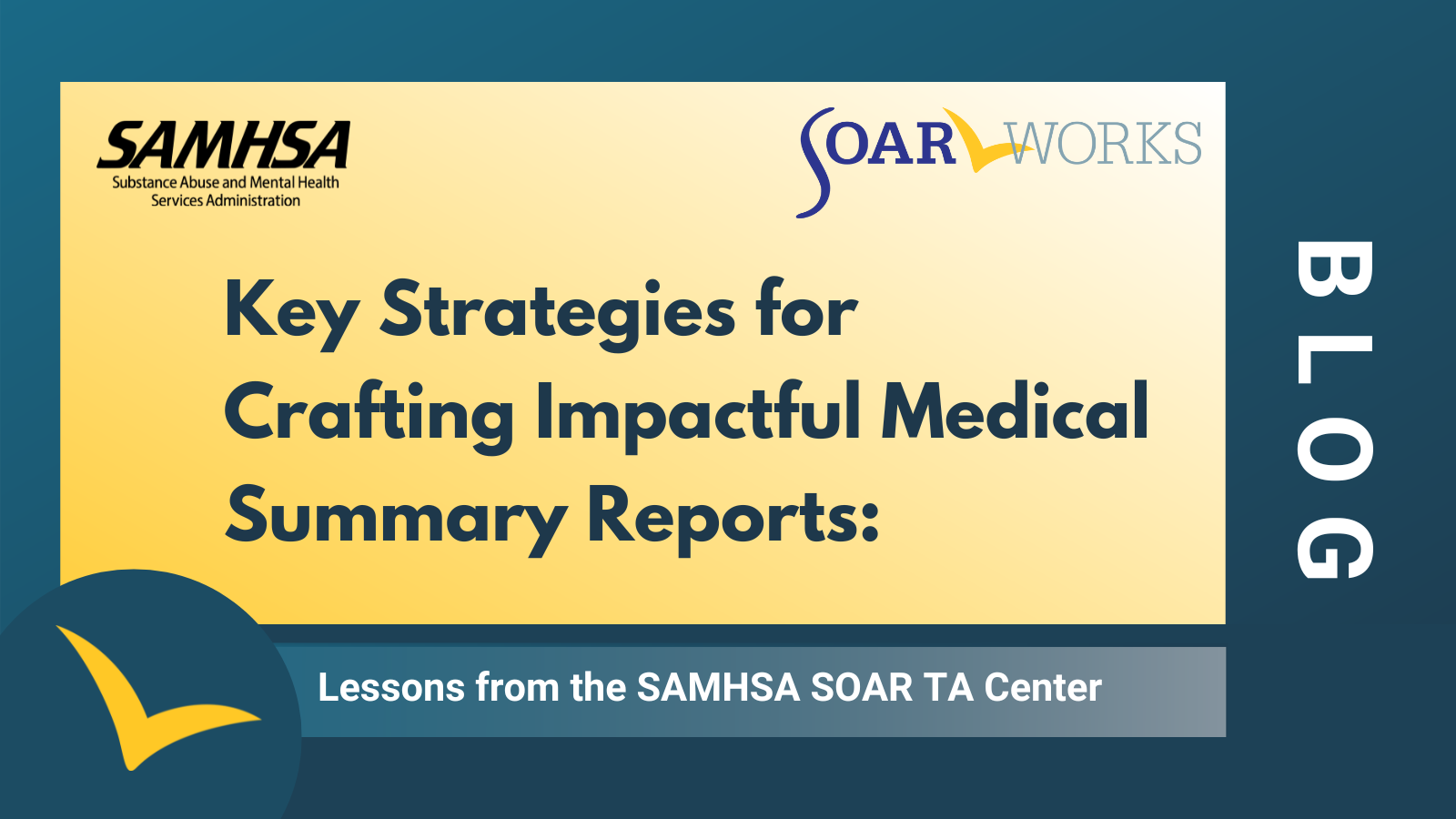Medical Summary Reports (MSRs) are a critical component of the SSI/SSDI Outreach, Access, and Recovery model. Research and data show that including an MSR with a SOAR-assisted SSI/SSDI application leads to higher approval rates. This blog draws on the SAMHSA SOAR Technical Assistance Center’s “Writing Effective Medical Summary Reports” webinar and answers providers’ questions about writing effective MSRs. These key takeaways can help you write your best MSRs!
What is a Medical Summary Report (MSR), and why is it important?
The MSR is a critical component of the SOAR model. It’s a narrative document that comprehensively reviews an applicant’s medical history, personal background, and functional limitations. The MSR is essential because it supports the applicant’s claim for Social Security disability benefits by clearly linking their conditions to their inability to work. Including an MSR in a SOAR-assisted SSI/SSDI application significantly increases approval rates, making it a vital part of the process.
What are the main sections of a Medical Summary Report (MSR)?
An effective MSR includes several sections:
- Introduction: Provides an overview of the applicant’s diagnoses and how these impact their ability to work.
- Personal History: Explains the applicant’s life, including educational, legal, and substance use histories as they relate to the applicant’s disability
- Occupational History: Describes the applicant’s work history and how their symptoms affected job performance.
- Medical and Mental Health Treatment: Documents the treatment history and links it to Social Security’s Listing of Impairments.
- Functional Information: Assesses the applicant’s ability to perform daily activities and interact with others.
- Summary: Recaps the report, emphasizing the applicant’s need for disability benefits.
How should I organize and begin writing a Medical Summary Report (MSR)?
Organization and setting aside dedicated time to focus on writing the MSR without interruptions is crucial. Start by gathering all relevant medical records, then organize them chronologically. You can begin writing sections as you collect information rather than waiting until you have everything. This approach allows you to develop a comprehensive report over time.
How do I ensure that my Medical Summary Report (MSR) uses respectful and person-centered language?
The language used in an MSR should always be respectful and person-centered. This means referring to the applicant by their name or as “the applicant” rather than using labels like “client.” Avoid defining someone by their diagnosis (e.g., “a person with schizophrenia” rather than “a schizophrenic”). This approach ensures that the report reflects the dignity and humanity of the applicant. For more guidance, view the Demonstrating SOAR Values with Words tip sheet.
What resources are available to help me write a Medical Summary Report (MSR)?
The SAMHSA SOAR TA Center provides various resources, including:
- The MSR Interview Guide and Template, which helps structure the report.
- Sample MSRs organized by diagnosis.
- Functional descriptions to guide writing in the most critical sections.
- Assistance from SOAR liaisons who can review redacted MSRs before submission.
How does the Social Security Administration’s (SSA) definition of disability affect writing the Medical Summary Report (MSR)?
SSA defines disability as the inability to engage in substantial gainful activity (SGA) due to a medically determinable impairment that is expected to last at least 12 months or result in death. The MSR must demonstrate that the applicant meets this definition by thoroughly documenting how their condition limits their ability to work.
What should I include in the Medical Summary Report’s (MSR) substance use history section?
When addressing substance use, it’s crucial to show that the applicant’s disability is not primarily due to their substance use. This involves documenting periods of non-use and demonstrating that symptoms persist even when the applicant is not using substances. This helps meet SSA’s criteria for determining whether substance use is a contributing factor.
How do I document work history in a Medical Summary Report, especially for jobs that weren’t “on the books?”
Documenting informal or under-the-table work is important as it provides insight into the applicant’s ability to function in a work environment. Describe the type of work, challenges faced, and how symptoms impacted job performance. This information is vital for understanding the applicant’s overall work capacity.
Why is using specific examples and quotes in a Medical Summary Report beneficial?
Specific examples and direct quotes from the applicant and those who know them provide concrete evidence of how symptoms impact daily functioning. These detailed descriptions help disability examiners understand the severity of the applicant’s condition, making the MSR more persuasive and effective.
Watch the full webinar on the SOAR website for a deeper dive into writing effective MSRs, including real-life examples and additional strategies.
This blog post was developed with the assistance of generative artificial intelligence.


